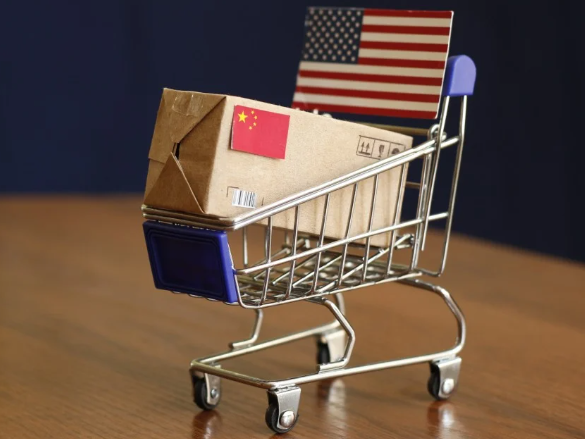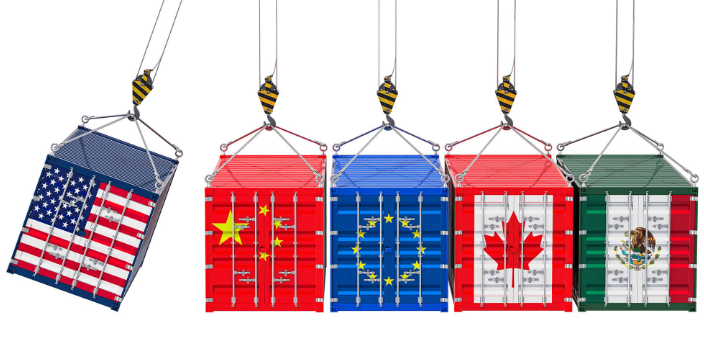Be your Logistics Department in China
Customized logistics solutions, your logistics expert in China
Customized logistics solutions, Shipping from China to the World
Tel:+8613424475220 Email:info@viputrans.com 
Tariff War for Ross-Border E-Commerce
The US tariff increase has led to a continuous increase in cross-border e-commerce logistics costs?
Under the US tariff iron curtain, cross-border e-commerce logistics will rise again? From 45% to 108% superposition?

Analysis of the tariff stacking mechanism: "death tax rate" from 45% to 70%
The current US tariff system for Chinese goods presents a composite structure of "basic tariff + special sanctions + indiscriminate strikes":
1. Basic tax rate: standard tariff determined according to the HS code of the goods (average about 3%-5%);
2.301 tariff: punitive tariff on specific Chinese goods (25% or 7.5%);
3.20% additional tariff: comprehensive sanction tariff added in March 2025;
4. Steel and aluminum special tax: 25% tariff on metal products;
5. Reciprocal tariff: 34% base tariff rate effective on April 2, "retaliatory measures" against the trade gap between China and the United States.
6. Typical case:
The comprehensive tax rate calculation of a steel household product (HS code 7321.90):
basic tax rate 4% + 25% for Article 301 + 20% additional tax + 25% steel and aluminum tax + 34% equivalent tariff = 108% tariff cost.
This means that the landed cost of a $100 product is $208, and the terminal selling price must exceed $300 to make a profit, which completely destroys the market competitiveness of price-sensitive products.
1. Collapse of cost structure
Profits of low-value goods are reduced to zero: After the cancellation of duty-free for packages below US$800, the customs clearance cost increases by US$3-5/ticket, and the 34% equivalent tariff is added.
The profit margin of 3C accessories, clothing and other categories plummets from 15% to -5%;
Compliance costs surge: The average daily demurrage fee caused by HS code classification errors is US$1,200/container, and the Amazon FBA warehouse entry delay rate reaches 37%;
Risk of capital chain rupture: The 30% tariff deposit system puts pressure on the cash flow of small and medium-sized sellers. A mobile phone case seller in Shenzhen was directly declared bankrupt because a US$2 million container was detained.
2. Supply chain stability encounters a century-long test
Transit trade routes are blocked: traditional tax avoidance channels such as Vietnam and Mexico are cut off by high tax rates of 46% and 32%, and the Southeast Asian supply chain cost of a certain Dengxian enterprise Surpassing China by 12%;
Capacity transfer paradox: Although 60% of sellers have tried to transfer to Southeast Asia, the lack of local infrastructure has led to a 45-day extension of the delivery cycle and a drop in inventory turnover to 1.2 times per year;
Raw material price fluctuations: Steel and aluminum taxes have pushed up the cost of packaging materials by 18%, and the packaging cost of a single Anker charger has exceeded the historical peak of $1.2.
3. Subversive reshuffle of market competition
Price advantage has completely collapsed: Temu platform data shows that after the tax increase, the sales of goods below $10 plummeted, and the $7250-$100 range became a new competitive red ocean.
The rise of localized brands has been hindered: Shein's North American independent station traffic has dropped by 40%, and it has been forced to shift the production capacity of its Turkish factory to the European market.
Platform game rules have changed: Amazon VC account operating costs have increased by 28%, and Walmart's DSV project has launched a 20% cost-sharing mechanism.
4. Global logistics system is systematically chaotic
Customs clearance efficiency has dropped precipitously: the inspection rate of the Port of Los Angeles has risen to 30%, and the average customs clearance time has been extended from 3 days to 11 days;
storage costs have risen nonlinearly: the rent of overseas warehouses in the East Coast of the United States has exceeded $15/square foot/month, a surge of 180% compared with 2024;
the freight rate mechanism is out of order: the West Coast route of the United States has experienced extreme fluctuations of "quoting 2500/FEU today and jumping to 3800 tomorrow".

1. Tariff cost transfer equation
Tiered pricing strategy: decompose the 34% tariff into "10% platform burden + 15% supplier sharing + 9% consumer transfer",
Tariff engineering innovation: by modifying the product material (such as magnesium-aluminum alloy instead of steel) to make the HS code fall into the low-tax category, a furniture company has reduced the tax rate by 23 percentage points;
Bonded processing mode: complete the final assembly process in the Mexican Free Trade Zone, and use the USMCA agreement to achieve compliant access to "Chinese components + North American manufacturing".
2. Supply Chain Resilience Reconstruction Project
Nearshore distributed warehousing: set up a "72-hour emergency warehouse" at the US-Mexico border, replace part of the sea transportation with truck transportation, and shorten the replenishment cycle to 5 days;
Blockchain traceability system: access to Hyperledger Fabric technology to achieve full-link visualization from Yiwu Small Commodity City to Amazon FBA warehouse, shortening the time for customs clearance dispute resolution by 80%
Dynamic capacity allocation: develop the "China mother factory + Southeast Asian satellite factory" model, and distribute orders in real time through the ERP system. A clothing company uses this to maintain a 13% gross profit margin.
3. Market value upgrade strategy
Scenario-based product innovation: develop a "tariff visualization function" for Generation Z, consumers can scan the code to view the tariff composition, and a luggage brand uses this to achieve a 27% increase in repurchase rate
Service premium model: launch a "tariff insurance service", promising that the price difference caused by tax rate changes will be made up by the platform, TikTok A store in Shop achieved a 300% increase in GMV through this;
Cultural empowerment path: implanting Hanfu elements into electronic product design, hedging 34% tariff costs through cultural premium, and a 3C brand's North American price increased by 40% and still maintained sales growth.
After the reciprocal tariff took effect on April 2, the cross-border e-commerce industry is experiencing a "Darwin moment":
1. Capitalization of compliance costs: It is expected that professional customs teams will become standard for enterprises in 2026, and related expenses will account for 8%-12% of revenue;
2. Deepening of technological moats: The error rate of AI tariff prediction algorithms must be controlled within +2%, otherwise it will lose its commercial application value;
3. Normalization of geo-arbitrage: A new triangular trade flow of "China R&D-ASEAN Manufacturing-Global Sales" will be formed in the RCEP region. It is expected that this model will carry 35% of China's cross-border e-commerce exports in 2027.

In this unprecedented tariff storm, the ones who can truly survive are not the largest or fastest companies, but those "adapters" who respond most swiftly to changes.
When the 34% tariff wall was erected, the ladder to climb over it had already been hidden in every flexible adjustment of the supply chain and every value innovation of the product. if you want to know more about transportation solutions, you can contact me at any time;Phone/Wechat/Whatsapp/Skype: +8618926970495
Our company can provide you with transportation solutions for railways, autos, and air transport.
Shawn.Liao (Mr.) ,E-MAIL:sales04@viputrans.com
Copyright © 2003-2025 VIPU Supply Chain Logistics Co., Ltd. | All Rights Reserved
LOGISTICS | E-COMMERCIAL FULFILLMENT | ABOUT US | CASE | NEWS | VIDEO | CONTACT US
We will find the fastest or the cheapest way for your shipment. Please specify: where from, where to, what to ship.